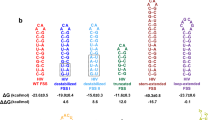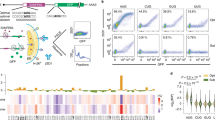Abstract
The ribosome translates the genetic information encoded in messenger RNA into protein. Folded structures in the coding region of an mRNA represent a kinetic barrier that lowers the peptide elongation rate, as the ribosome must disrupt structures it encounters in the mRNA at its entry site to allow translocation to the next codon. Such structures are exploited by the cell to create diverse strategies for translation regulation, such as programmed frameshifting1,2, the modulation of protein expression levels3,4, ribosome localization5 and co-translational protein folding6. Although strand separation activity is inherent to the ribosome, requiring no exogenous helicases7, its mechanism is still unknown. Here, using a single-molecule optical tweezers assay on mRNA hairpins, we find that the translation rate of identical codons at the decoding centre is greatly influenced by the GC content of folded structures at the mRNA entry site. Furthermore, force applied to the ends of the hairpin to favour its unfolding significantly speeds translation. Quantitative analysis of the force dependence of its helicase activity reveals that the ribosome, unlike previously studied helicases, uses two distinct active mechanisms to unwind mRNA structure: it destabilizes the helical junction at the mRNA entry site by biasing its thermal fluctuations towards the open state, increasing the probability of the ribosome translocating unhindered; and it mechanically pulls apart the mRNA single strands of the closed junction during the conformational changes that accompany ribosome translocation. The second of these mechanisms ensures a minimal basal rate of translation in the cell; specialized, mechanically stable structures are required to stall the ribosome temporarily1,2. Our results establish a quantitative mechanical basis for understanding the mechanism of regulation of the elongation rate of translation by structured mRNAs.
This is a preview of subscription content, access via your institution
Access options
Subscribe to this journal
Receive 51 print issues and online access
$199.00 per year
only $3.90 per issue
Buy this article
- Purchase on Springer Link
- Instant access to full article PDF
Prices may be subject to local taxes which are calculated during checkout



Similar content being viewed by others
References
Giedroc, D. P. & Cornish, P. V. Frameshifting RNA pseudoknots: structure and mechanism. Virus Res. 139, 193–208 (2009)
Tsuchihashi, Z. Translational frameshifting in the Escherichia coli dnaX gene in vitro . Nucleic Acids Res. 19, 2457–2462 (1991)
Nackley, A. G. et al. Human catechol-O-methyltransferase haplotypes modulate protein expression by altering mRNA secondary structure. Science 314, 1930–1933 (2006)
Duan, J. B. et al. Synonymous mutations in the human dopamine receptor D2 (DRD2) affect mRNA stability and synthesis of the receptor. Hum. Mol. Genet. 12, 205–216 (2003)
Young, J. C. & Andrews, D. W. The signal recognition particle receptor alpha subunit assembles co-translationally on the endoplasmic reticulum membrane during an mRNA-encoded translation pause in vitro . EMBO J. 15, 172–181 (1996)
Watts, J. M. et al. Architecture and secondary structure of an entire HIV-1 RNA genome. Nature 460, 711–716 (2009)
Takyar, S., Hickerson, R. P. & Noller, H. F. mRNA helicase activity of the ribosome. Cell 120, 49–58 (2005)
Wen, J. D. et al. Following translation by single ribosomes one codon at a time. Nature 452, 598–603 (2008)
Yusupova, G. Z., Yusupov, M. M., Cate, J. H. D. & Noller, H. F. The path of messenger RNA through the ribosome. Cell 106, 233–241 (2001)
Keller, D. & Bustamante, C. The mechanochemistry of molecular motors. Biophys. J. 78, 541–556 (2000)
Patel, S. S. & Donmez, I. Mechanisms of helicases. J. Biol. Chem. 281, 18265–18268 (2006)
Johnson, D. S., Bai, L., Smith, B. Y., Patel, S. S. & Wang, M. D. Single-molecule studies reveal dynamics of DNA unwinding by the ring-shaped T7 helicase. Cell 129, 1299–1309 (2007)
Lionnet, T., Spiering, M. M., Benkovic, S. J., Bensimon, D. & Croquette, V. Real-time observation of bacteriophage T4 gp41 helicase reveals an unwinding mechanism. Proc. Natl Acad. Sci. USA 104, 19790–19795 (2007)
Manosas, M., Xi, X. G., Bensimon, D. & Croquette, V. Active and passive mechanisms of helicases. Nucleic Acids Res. 38, 5518–5526 (2010)
Kim, S., Schroeder, C. M. & Xie, X. S. Single-molecule study of DNA polymerization activity of HIV-1 reverse transcriptase on DNA templates. J. Mol. Biol. 395, 995–1006 (2010)
Betterton, M. D. & Julicher, F. Opening of nucleic-acid double strands by helicases: active versus passive opening. Phys. Rev. E 71, 011904 (2005)
Tinoco, I. & Wen, J. D. Simulation and analysis of single-ribosome translation. Phys. Biol. 6, 025006 (2009)
Rodnina, M. V. et al. GTPase mechanisms and functions of translation factors on the ribosome. Biol. Chem. 381, 377–387 (2000)
Zuker, M. Mfold web server for nucleic acid folding and hybridization prediction. Nucleic Acids Res. 31, 3406–3415 (2003)
Tinoco, I. & Bustamante, C. The effect of force on thermodynamics and kinetics of single molecule reactions. Biophys. Chem. 101–102, 513–533 (2002)
Lohman, T. M., Tomko, E. J. & Wu, C. G. Non-hexameric DNA helicases and translocases: mechanisms and regulation. Nature Rev. Mol. Cell Biol. 9, 391–401 (2008)
Fischer, N., Konevega, A. L., Wintermeyer, W., Rodnina, M. V. & Stark, H. Ribosome dynamics and tRNA movement by time-resolved electron cryomicroscopy. Nature 466, 329–333 (2010)
Moazed, D. & Noller, H. F. Intermediate states in the movement of transfer RNA in the ribosome. Nature 342, 142–148 (1989)
Frank, J. & Agrawal, R. K. A ratchet-like inter-subunit reorganization of the ribosome during translocation. Nature 406, 318–322 (2000)
Schuwirth, B. S. et al. Structures of the bacterial ribosome at 3.5 Å resolution. Science 310, 827–834 (2005)
Valle, M. et al. Locking and unlocking of ribosomal motions. Cell 114, 123–134 (2003)
Peske, F., Matassova, N. B., Savelsbergh, A., Rodnina, M. V. & Wintermeyer, W. Conformationally restricted elongation factor G retains GTPase activity but is inactive in translocation on the ribosome. Mol. Cell 6, 501–505 (2000)
Chen, G., Chang, K. Y., Chou, M. Y., Bustamante, C. & Tinoco, I. Triplex structures in an RNA pseudoknot enhance mechanical stability and increase efficiency of-1 ribosomal frameshifting. Proc. Natl Acad. Sci. USA 106, 12706–12711 (2009)
Uemura, S. et al. Peptide bond formation destabilizes Shine–Dalgarno interaction on the ribosome. Nature 446, 454–457 (2007)
Cukras, A. R., Southworth, D. R., Brunelle, J. L., Culver, G. M. & Green, R. Ribosomal proteins S12 and S13 function as control elements for translocation of the mRNA: tRNA complex. Mol. Cell 12, 321–328 (2003)
Acknowledgements
We thank members of the Tinoco and Bustamante labs for helpful discussions, especially S. B. Smith for his help with the optical tweezers, J. Moffitt for advice on data analysis and C. Kaiser for suggestions. Our work was supported by grants from the National Institutes of Health (to I.T., C.B. and H.F.N.) and the Human Frontiers Science Program (to I.T. and H.F.N.).
Author information
Authors and Affiliations
Contributions
X.Q. and J.-D.W. conducted the experiments and performed the analysis; X.Q., J.-D.W. and L.L. prepared and provided experimental materials; and all authors helped to write the paper.
Corresponding authors
Ethics declarations
Competing interests
The authors declare no competing financial interests.
Supplementary information
Supplementary Information
The file contains Supplementary Figures 1-8 with legends, Supplementary Tables 1-2, a Supplementary Discussion and additional references. (PDF 614 kb)
Rights and permissions
About this article
Cite this article
Qu, X., Wen, JD., Lancaster, L. et al. The ribosome uses two active mechanisms to unwind messenger RNA during translation. Nature 475, 118–121 (2011). https://doi.org/10.1038/nature10126
Received:
Accepted:
Published:
Issue Date:
DOI: https://doi.org/10.1038/nature10126
This article is cited by
-
Specific length and structure rather than high thermodynamic stability enable regulatory mRNA stem-loops to pause translation
Nature Communications (2022)
-
The birth of piRNAs: how mammalian piRNAs are produced, originated, and evolved
Mammalian Genome (2022)
-
Effects of prolonged incubation period and centralized quarantine on the COVID-19 outbreak in Shijiazhuang, China: a modeling study
BMC Medicine (2021)
-
Optical tweezers in single-molecule biophysics
Nature Reviews Methods Primers (2021)
-
Structural dynamics of single SARS-CoV-2 pseudoknot molecules reveal topologically distinct conformers
Nature Communications (2021)
Comments
By submitting a comment you agree to abide by our Terms and Community Guidelines. If you find something abusive or that does not comply with our terms or guidelines please flag it as inappropriate.



